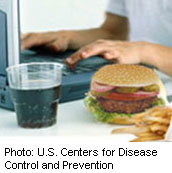
THURSDAY, March 18 (HealthDay News) — The obesity epidemic is hitting children harder than ever, with 7.3 percent of boys and 5.5 percent of girls classified as extremely obese in a California study, researchers from Kaiser Permanente report.
The news is even worse for black and Hispanic kids: Among black teenage girls, 11.9 percent were classified as extremely obese, as were 11.2 percent of Hispanic teenage boys. Extreme obesity among children is defined as weighing more than 1.2 times the 95th percentile, or having a body-mass index (BMI) of 35 kilograms per meter squared.
“There is an alarming high frequency of extremely obese children,” said study author Corinna Koebnick, a research scientist at Kaiser Permanente Southern California Department of Research and Evaluation in Pasadena.
Koebnick said the obesity epidemic is driven by a combination of lack of physical activity and poor eating habits. “It’s unhealthy eating habits — fast food versus slow food,” she said.
Parents need to be role models for their children, Koebnick stressed. “There are studies suggesting parent’s weight has a significant influence on the child’s weight,” she noted.
Extreme obesity can lead to serious health problems such as diabetes and heart disease, Koebnick added.
“We need to watch these extremely obese kids more carefully, and we need to try to prevent adverse health effects that may come up in the near future,” she said.
“Children who are extremely obese may continue to be extremely obese as adults, and all the health problems associated with obesity are in these children’s futures. Without major lifestyle changes, these kids face a 10 to 20 years shorter life span and will develop health problems in their 20s that we typically see in 40- [to] 60-year-olds,” Koebnick said in a Kaiser Permanente news release.
Although these findings cover only children in southern California, Koebnick thinks they are representative of what is happening throughout the United States.
The report is published in the March 18 online edition of the Journal of Pediatrics.
For the study, Koebnick’s team collected data on 710,949 children and teens aged 2 to 19 who belonged to Kaiser Permanente Southern California integrated health plan in 2007 and 2008.
Using these data, the researchers found that 7.3 percent of boys and 5.5 percent of girls were extremely obese, which is more than 45,000 extremely obese children among all the children studied.
Obesity peaked at age 10 for boys and age 12 for girls. The most extremely obese were black teenage girls and Hispanic boys. The least extremely obese were Asian-Pacific Islanders and white children, the researchers found.
Samantha Heller, a dietitian, nutritionist and exercise physiologist, said that “the results of this survey are not surprising, but are heartbreaking when you consider the health consequences that these children will be facing, not to mention the social, emotional and psychological repercussions.”
It is critical for parents to learn how to provide healthy food for their families, Heller noted. “Healthy food can be affordable and delicious but consumers are led to believe that fast food, junk food and sweets are the easiest and cheapest way to go,” she said.
The public is bombarded with food advertising that targets children, Heller said. The 2008 Federal Trade Commission Report to Congress found that more than $1.6 billion was spent in 2006 marketing food and beverages to children.
“Imagine if that money, or even a fraction of it, was used to promote healthy foods like vegetables, fruits, whole grains and beans, and nutrition education for the public,” she said. “People would learn how to buy and prepare healthy foods on a budget and we could reduce the prevalence of obesity and chronic diseases like diabetes, heart disease and cancer, in our children,” Heller explained.
“Health professionals, food companies and local and state governments need to find ways to help educate, motivate and empower adults and children to lead healthier lives before it is too late to save our children,” Heller added.
More information
For more information on childhood obesity, visit the Nemours Foundation.

